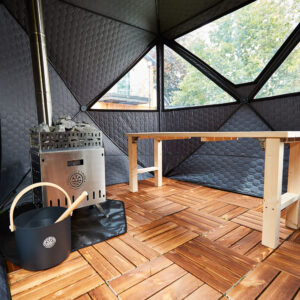
Ice Baths: A Key to Enhanced Recovery and Vitality for Athletes
Explore how ice baths can boost recovery and enhance vitality for athletes. Discover practical tips and insights to elevate your performance. Read more!
Spend Over £500 To Get Free UK Delivery - Excludes Certain Postcodes & Round Ice Baths

As a runner, you’re likely familiar with the muscle soreness that comes after a long run. But have you ever considered soaking in an ice bath for relief? Research indicates that cold water therapy, such as ice baths, can greatly reduce inflammation and aid in muscle recovery. But before you plunge into a tub of ice, it’s essential to understand the science behind it and how to safely incorporate this practice into your recovery routine. Interested? Let’s explore further.

While you may have heard of cold water therapy, understanding how it works can help you utilise it effectively in your running recovery routine. This therapy, often through ice baths, is used to relieve muscle soreness post workout.
It revolves around the principle of vasoconstriction – the narrowing of blood vessels. When you emerge from cold water, your blood vessels dilate, triggering a rush of nutrient-rich blood that aids muscle repair.
Cold water therapy isn’t just about reducing muscle inflammation; it also helps flush out lactic acid, a byproduct of exercise that contributes to muscle fatigue and discomfort.
With consistent use, you’ll notice enhanced running performance, faster recovery times, and less muscle soreness. It’s a worthwhile addition to your recovery protocol.
To fully appreciate the benefits of cold water therapy, it’s essential to explore the scientific mechanisms driving these effects.
When you plunge into an ice bath, your body responds by constricting blood vessels, reducing muscle inflammation. This process, known as vasoconstriction, helps decrease swelling and tissue breakdown while numbing your nerves, easing pain.
Your body also increases blood circulation to critical organs, fundamentally jump-starting your system’s recovery process. As you warm up post-bath, blood vessels dilate, flushing your muscles with nutrient-rich blood, expediting healing.
These physiological reactions to cold water immersion, coupled with a decrease in lactic acid build-up, contribute to the recovery benefits, making ice baths a valuable tool in your post-run regimen.

Even if you’re already aware of the recovery benefits of ice baths, you might be wondering how they specifically improve running performance.
Here’s how ice baths work: When you expose your body to the cold, your blood vessels constrict. This slows down metabolic activity, reducing muscle soreness and tissue breakdown.
Then, as you warm back up, blood rushes back into those areas, speeding up the muscle recovery process. This cycle can help enhance your endurance, making subsequent runs feel easier.
So, by regularly incorporating ice baths into your post-run routine, you’re not just speeding up recovery time. You’re directly boosting your performance, helping you run faster, longer, and with less discomfort.
It’s a cold, hard fact: ice baths can be a game-changer for runners.
Not only do ice baths enhance your running performance, but they also play a significant role in active recovery.
They’re a scientifically backed method to speed up recovery and reduce muscle soreness after a strenuous run.
Here’s how ice baths aid in active recovery:
Incorporate ice baths into your recovery routine for these benefits!

Diving into an at-home ice bath is a practical, cost-effective way to reap the benefits of cold water therapy.
Begin by filling your bathtub with cold water. Then, gradually add ice until the water’s temperature drops to a chilly 10-15 degrees Celsius.
Start your at-home ice bath by filling your tub with cold water, then slowly add ice until it’s a frigid 10-15 degrees Celsius.
Don’t just jump in; allow your body to acclimate to the cold, starting with your feet and gradually submerging yourself. Aim to soak for 10-20 minutes, but listen to your body. If you start feeling too uncomfortable, it’s okay to cut the session short.
Post-bath, warm up slowly to prevent dizziness. Remember, taking ice baths isn’t a competition; it’s about aiding your recovery.
As you experiment with cold water therapy methods for recovery, you might consider cold plunges as an alternative to ice baths. A cold plunge integrates into your recovery routine quite seamlessly and can be an effective method for reducing muscle soreness.
Here are three key points to remember:
Explore this alternative and see how it benefits your post-run recovery.

While you might be sceptical about the merits of ice baths, runners around the globe swear by their effectiveness.
Scientifically backed, ice baths have proven good for runners as a recovery method. They help to reduce inflammation, a common issue faced post-run, promoting a faster healing process. The cold temperature constricts blood vessels, flushing toxins from your muscles.
When you subsequently warm up, the increased blood flow speeds up your body’s natural recovery. Regular ice baths contribute to less muscle soreness and better performance on your next run.
Although ice baths may be beneficial, not everyone has the time or resources to regularly engage in this method of recovery.
Cold showers, however, offer a practical and accessible recovery modality. After a strenuous run, stepping into a cold shower can help alleviate muscle soreness. The cold water aids in reducing inflammation and enhancing blood circulation, thereby expediting recovery.
To maximise the benefits, follow these steps:
You might wonder how hot baths fit into the recovery equation, especially after discussing the benefits of cold showers.
Hot baths and cold water therapy, while both beneficial, offer different advantages. Hot baths primarily focus on muscle relaxation and stress reduction. The warm water increases blood flow, aiding in the removal of metabolic waste, and induces sleep by relaxing the central nervous system.
On the other hand, cold water therapy reduces inflammation and triggers a faster recovery process. The cold temperatures constrict your blood vessels, reducing muscle soreness and speeding up your body’s return to its normal state post-exercise.
Both hot baths and cold water therapy have their place in recovery, depending on your specific needs and preferences.
Before jumping into an ice bath, it’s crucial to understand and follow certain safety guidelines to guarantee the practice is effective and safe.
These safety guidelines for ice baths will aid in your effective recovery.

Even as you push your limits during training, it’s essential not to overlook the value of rest and recovery. These periods are when your body repairs and strengthens itself in the response to exercise stress.
As part of your recovery strategy, ice baths can be highly beneficial. Immersing in cold water after a run can reduce muscle soreness by restricting blood flow, flushing out metabolic waste, and reducing inflammation. This method, known as cryotherapy, aids in quickening your recovery process.
The result? You bounce back quicker, ready to tackle your next run. Remember, incorporating rest and recovery, including strategies like ice baths, is as crucial to your training plan as the actual running itself.

While ice baths serve an essential role in your recovery strategy, proper nutrition is equally paramount.
To mitigate muscle soreness and expedite recovery, you must fuel your body with essential nutrients. Strategically integrating nutrition in your recovery plan can greatly enhance the benefits of an ice bath.
Incorporating ice baths into a thorough recovery strategy that includes other techniques can greatly boost your recuperation and performance.
By combining cold water therapy with active recovery methods like stretching and foam rolling, you can enhance the benefits of each, reducing muscle soreness and speeding up your bounce-back time.
The cooling effect of ice baths helps constrict blood vessels, flushing lactic acid from your muscles, while active recovery techniques promote flexibility and tissue health.
Experience the power of ice baths in constricting blood vessels and flushing lactic acid, coupled with active recovery for improved flexibility and tissue health.
Concurrently, these methods optimise your body’s healing process and improve your running performance.
Beyond the physical advantages, cold water therapy offers significant mental health benefits. When you submerge in cold water, your body responds in ways that may boost your mood and reduce anxiety.
If you’ve Raynaud’s disease, you shouldn’t take ice baths. Cold can trigger Raynaud’s attacks, causing blood vessels to narrow drastically. Always consult your doctor before starting new health practices, especially when dealing with medical conditions.
While cold water therapy boosts recovery, it’s not risk-free. You may experience hypothermia, frostbite, or shock from abrupt temperature shifts. Those with circulatory issues or Raynaud’s disease should consult a doctor before diving in.
As a pregnant runner, you should consult your healthcare provider before using ice baths. Reduced body temperature might affect your baby’s well-being. It’s safer to use gentler recovery methods during pregnancy. Always prioritise your baby’s safety.
Yes, you can enhance your ice bath benefits with essential oils. Eucalyptus oil aids muscle relaxation, while peppermint oil can relieve pain. Always dilute these oils in a carrier oil before adding to your bath.
Cold water therapy can enhance your joint health and flexibility as a runner. It reduces inflammation, alleviates joint pain, and increases circulation, leading to improved flexibility and mobility. However, don’t replace it with regular stretching.
Embrace the chill, runner! Incorporating ice baths into your recovery routine can supercharge your performance and boost your mood. Remember, it’s not just about pushing your limits, but also about how you rest and refuel. Combine cold therapy with balanced nutrition and other recovery techniques for holistic wellness. Immerse yourself in this exhilarating, icy experience and discover not just a resilient runner in you, but a stronger, happier individual. It’s not just a coincidence, it’s science. So, are you ready to take the plunge?

Founder of Urban Ice Tribe

Explore how ice baths can boost recovery and enhance vitality for athletes. Discover practical tips and insights to elevate your performance. Read more!

There’s nothing quite like the raw, elemental power of a pop-up sauna. Portable, authentic, and deeply restorative, it’s the perfect way to reconnect with nature and yourself. But to take your sauna ritual to the next level, the right sauna accessories can make all the difference.

Transform your outdoor space into a personal wellness retreat with the Urban Ice Tribe Sauna Tent. This detailed setup guide walks you through every step, from unboxing to your first steam session, blending practical instruction with the mindful ritual of heat therapy.
Helping men & women release anxieties & limiting beliefs to experience a life of freedom using powerful breathwork, cold water therapy, movement & sound healing.

No spam, notifications only about new products, updates, offers and announcements.